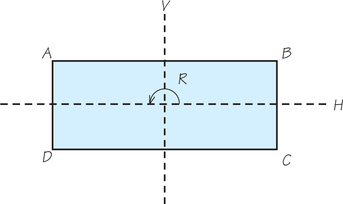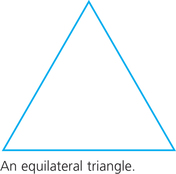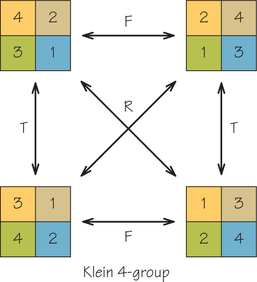19.5 19.4 Symmetry Groups
We mentioned earlier that the key mathematical idea about detecting and analyzing symmetry is to look not at the motifs of a pattern but at its symmetries, the transformations that preserve the pattern.
The symmetries of a pattern have four notable properties:
- If we combine two symmetries by applying first one and then the other, we get another symmetry.
- There is an identity, or “null,” symmetry that doesn’t move anything but leaves every point of the pattern exactly where it is.
- Each symmetry has an inverse, or “opposite,” that undoes it and also preserves the pattern. A rotation is undone by an equal rotation in the opposite direction, a reflection is its own inverse, and a translation or glide reflection is undone by another of the same distance in the opposite direction.
- In applying a number of symmetries one after the other, we may combine consecutive ones without affecting the result (associativity). For example, if we have symmetries A followed by B followed by C, we can do either of the following: first combine A with B, apply that symmetry, and then apply C; or first apply A and then follow that by applying the combination of B with C. That is, we can “associate” adjacent symmetries, but we must observe the overall order (A, B, C) in which they occur.
EXAMPLE 3 Symmetries of a Rectangle
Symmetries of a Rectangle
What are the symmetries of a rectangle?
Consider the rectangle of Figure 19.15.

Its symmetries, the rigid motions that bring it back to coincide with itself (even as they interchange the labeled corners), are as follows:
- The identity symmetry I, which leaves every point where it is
- A 180° (half-turn) rotation R around its center
- A reflection V in the vertical line through its center
- A reflection H in the horizontal line through its center
Now, convince yourself that the symmetries fulfill the four properties above:
- Combining any pair by applying first one and then the other is equivalent to one of the others. It’s handy to have a notation for this combining; if we apply V first and then H, we will write the result as VH—in other words, we apply the sequence of actions from left to right. You can check that the result is the same as applying R; that is, VH=R. Check this by following where the corner A goes under the symmetries. Practice combining symmetries by making yourself a “multiplication table” of them.
Page 803
The element I is an identity element.
- Each element is its own inverse. For example, rotating by 180°, then doing it again, gets the rectangle back to coincide with itself; in our notation, .
- Try some examples to verify that associativity holds. For instance, check that . In other words, applying then then , we get the same result if we combine the first two and then apply the third, or if we apply the first one and then apply the combination of the second two.
Self Check 6
What are the symmetries of a square?
- , where and are horizontal and vertical reflection (as in the rectangle case), is a quarter turn, and and are reflections across the diagonals.
The four properties of symmetries of an object are common to many kinds of mathematical objects. The properties characterize what mathematicians call a group. Various familiar collections of numbers, together with operations on them, form groups.
EXAMPLE 4 A Group of Numbers
A Group of Numbers
Show that if we regard numbers as symmetries, with multiplication as the way of combining them, the positive real numbers have the four properties of symmetries noted above.
- Multiplying two positive real numbers yields another positive real number.
- The positive real number 1 is an identity element.
- Any positive real number has an inverse () in the collection.
- In multiplying several numbers, it doesn’t matter if we first multiply some adjacent pairs of numbers; that is, it doesn’t matter how we group or parenthesize the multiplication. For instance, is equal to and also to .
Hence, we say that the positive real numbers form a group under multiplication.
Group DEFINITION
A group is a collection of elements {} and an operation ° between pairs of them such that the following properties hold:
- Closure: The result of one element operating on another is itself an element of the collection: is in the collection.
- Identity element: There is a special element , called the identity element, such that the result of an operation involving the identity and any element is that same element: and .
- Inverses: For any element , there is another element, called its inverse and denoted , such that the result of an operation involving an element and its inverse is the identity element: and .
- Associativity: The result of several consecutive operations is the same regardless of grouping or parenthesizing, provided that the consecutive order of operations is maintained: .
EXAMPLE 5 A Group of Non-Numbers
A Group of Non-Numbers
With all your experience with arithmetic, numbers are concrete to you, even if thinking of them in terms of a group isn’t yet familiar. Here, we look at a very simple “abstract” group. The group is a collection of just three elements {A, B, C}, and it is convenient to show how the operation behaves by giving a table of its results as follows:

The table is organized so that, for example, we find the result of A ▴ B by looking in the row for A and the column for B, finding B. So . Similarly, . We confirm that indeed this set is a group under the operation.
Since all the entries in the table are from {A, B, C}, the set is closed under the operation. You should identify which element serves as an identity element. What is the inverse to A? To B? To C? To check associativity would require checking the results of all possible products , where each of X, Y, and Z can be any of A, B, or C. We won’t go to that (tedious) length, but you should check just one example. For instance, , while . Also, can you see why there are products to check?
This particular abstract group can be interpreted concretely in several ways. One interpretation is in terms of an equilateral triangle.

Each of A, B, and C is a rotation of the triangle about its center. A is a rotation by 0°, B is a rotation clockwise by 120° (one-third of a complete turn), and C is a rotation counterclockwise by 120°. The operation ▴ just gives the result of doing one rotation followed by another. For example, is first to rotate the triangle 120° clockwise, then rotate it 120° counterclockwise—which leaves it as if it had not rotated at all; that is, as rotated by 0°. Hence, .
We have, in fact, explored here some of the symmetries of an equilateral triangle. (What other symmetries does an equilateral triangle have? Think of it as a rosette pattern.)
Symmetry Group of a Pattern DEFINITION
The symmetries that preserve a pattern form the symmetry group of the pattern.
EXAMPLE 6 Group Theory in Your Room, or More Than Once Upon a Mattress
Group Theory in Your Room, or More Than Once Upon a Mattress
Have you ever turned a mattress? The purpose of this usually seasonal practice is to even out lumps and sags and make the mattress last longer and be more comfortable.
There are various ways to “turn” a mattress, but they all require that the mattress fit back on the bed. What are all those ways?
For this example, make yourself a “mattress” from a (nonsquare) rectangular sheet of paper. (It’s a lot easier to flip a piece of paper than a real mattress!) Label the initial position of the “mattress": Write “UP” in the middle of the top surface of the paper and label the edges in clockwise order “TOP,” “RIGHT,” “BOTTOM,” and “LEFT.” Then turn the sheet over so that the top edge is again at the top. Label this surface of the paper “BOTTOM” in the middle and label the edges in clockwise order “TOP,” “RIGHT,” “BOTTOM,” and “LEFT.” Now turn the sheet over again to the initial position.
We’ll designate the turning over of the paper that you just did as follows:
- Flip (turn it over, left and right switch), denoted by , amounts to a 180° rotation around an axis running from bottom to top of the mattress.
- Rotation (up side stays up, top and bottom switch), denoted by , amounts to a 180° rotation of the mattress as seen from above, that is, around a vertical axis through the center of the mattress.
- Toss (turn it over and switch top and bottom), denoted by , corresponds to a 180° rotation of the mattress around a horizontal axis across the middle of the short side of the mattress.
How many different positions are there for the mattress? Satisfy yourself that there are really only four positions for the mattress that fit it back on the bed: the results of the turns , , and —together with the “un-turn,” which we denote by . These four turns together form a group {, , , }. The group operation is to perform one turn followed by another.
Performing one of the turns, followed by a subsequent one in the next season, actually gives the same result as a single turn; for example, doing followed by puts the mattress in the same position as doing just . This fact is the closure property of the group.
The identity element of the group is the “un-turn” . Each turn is its own inverse: Performing it twice in a row puts the mattress back in the initial position .

Associativity of the turns is true, though it is tedious to check, but this necessary property of a group indeed holds.
The same structure of operations holds for turning your pillow. Any group with four elements, each of which is its own inverse, has basically the same abstract structure, called the Klein 4-group [after Felix Klein (1849–1925), who classified geometries by their symmetry groups].
EXAMPLE 7 Symmetry Groups of Strip Patterns
Symmetry Groups of Strip Patterns
Each of the strip patterns of Figure 19.11 on page 795 has a different group of symmetries. What do they have in common, and how do they differ?
The pattern of Figure 19.11a is preserved only by translations. If we let denote the smallest translation to the right that preserves the pattern, then the pattern is also preserved by (which we write as ), by , and so forth. Although the pattern looks the same after each of these translations by different distances, we can tell these translations apart if we number each copy of the motif and observe which other motif it is carried into under the symmetry.
For instance, takes each motif into another one that is located two motifs to the right. The symmetry has an inverse among the symmetries of the pattern: the smallest translation to the left that preserves the pattern; and (which we write as ), , and so forth also are symmetries. The entire collection of symmetries of the pattern is
From this listing, you see that it is natural to think of the identity as being . All of the strip patterns are preserved by translations, so the symmetry group of each includes the subgroup of all translations in this list. We say that the group is generated by and we write the group as , where between the angle brackets we list symmetries that, in combination, produce all the group elements. The symmetry group of Figure 19.11e includes, in addition, a glide reflection and all combinations of the glide reflection with the translations. Doing two glide reflections is equivalent to doing a translation, which we express as . The glide is only “half as far” as the shortest translation that preserves the pattern. Check that . The symmetry group of the pattern is
The pattern of Figure 19.11c is preserved by vertical reflections at regular intervals. If we let denote reflections at a fixed particular location, the other reflections can be obtained as combinations of and . To get a handle on what each of the symmetries does, it helps to make a “simplified” copy of the strip (we use Ws), number fixed positions on the page, and identify individual copies of the Ws with letters ("invisible,” because the letters are not part of the pattern) as in the following:

The symmetries move the Ws among the numbered positions. Let be the reflection across the vertical line through the middle of position 3, and let be the translation that moves each W one square to the right. To familiarize yourself with the symmetries, write out the result of each of , , and (recall, this is followed by ; for simplicity, we can omit the operation sign between symmetries). In each case, where does end up? The symmetry group of the pattern, the list of all of the symmetries, is
This group is notable because not all its elements satisfy the commutative property that , which you are accustomed to for numerical operations (). In fact, we do not have , but instead . We can express this group compactly as
where we list the symmetries that generate the group and indicate any relations that hold between them.
Self Check 7
Verify that by working out the effect of each, using your simplified strip.
- Both and produce with in position 3 (the position of the axis of the vertical reflection ).
We have made a transition from thinking about patterns in geometrical terms to reasoning about them in algebraic notation—in effect, applying one branch of mathematics to another. This kind of cross-fertilization is characteristic of contemporary mathematics. The concept of a group is a fundamental one in the mathematical field of abstract algebra. The generality (“abstractness”) is exactly why groups and other algebraic structures arise in so many applications, in areas ranging from crystallography, quantum physics, and cryptography, to error-correcting codes (see Chapters 16 and 17) and anthropology (describing kinship systems).